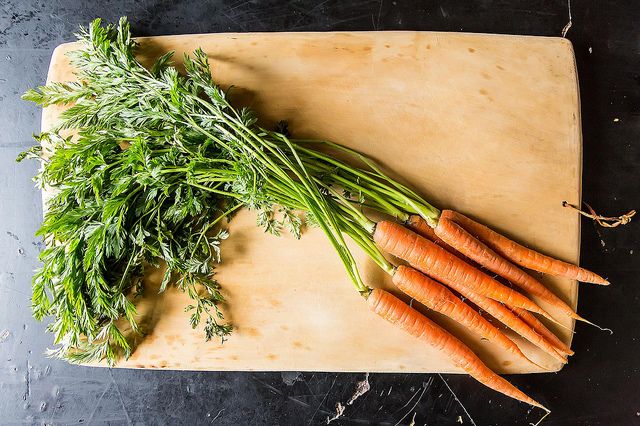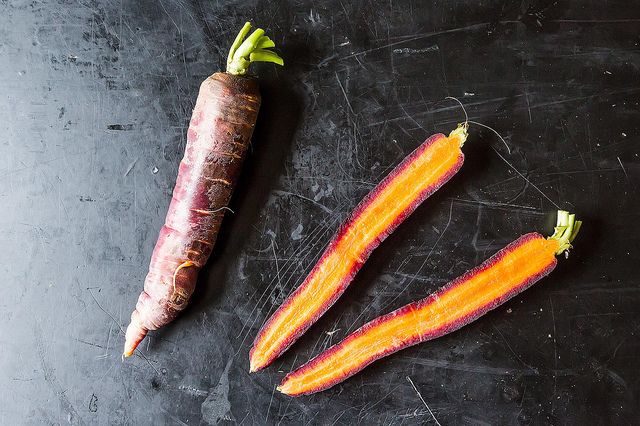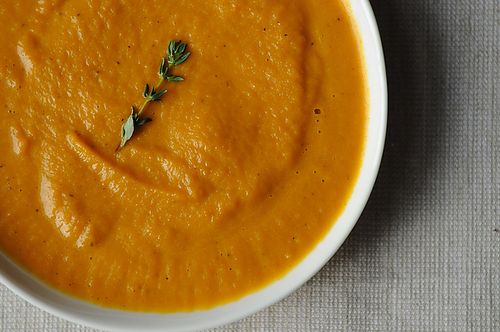Every other Thursday, we bring you Nicholas Day -- on cooking for children, and with children, and despite children. Also, occasionally, on top of.
Today: Nicholas gives carrots some love, even the uncool ones. (Plus, six ways to let them save dinner.)

In elementary school, carrots were the vegetable that never got picked for kickball. Carrots are me, basically.
All the other produce goes first: the fragile greens, the desiccating fungi, the long-suffering stalk of broccoli. And then, when the crisper nearly has been picked clean, when the carrots are sure that they’ll be taken next, they hear the fateful words: Nope. Only carrots.
And then you go shopping and put everything on top of the carrots.

This is about what to do when, in some archeological dig of the fridge, after carbon-dating the jar of horseradish, you discover those carrots again.
Do you know those articles for carrots that talk about how exquisite carrots are at certain times of year, and how our false conception of carrots as a storage, year-round vegetable blinds us to their true glory?
This is not that sort of article.
Did you read that Times article last fall about the new wave of carrot auteurs—the chefs who are reinventing the root: carrot tartare, carrot mousse, carrot cotton candy, cedar-plank roasted carrots?
This is not that sort of article either.
This is about the five-pound bag of carrots you bought, at least two weeks ago, with the very best of intentions. Do they still have dirt clinging to their wrinkles? No. Are they rainbow-hued? Please. Were they dug in this millennium? No telling!

I like carrots. I even like supermarket, bulk-bagged carrots. They are too sweet, they are overly eager, they are a color rarely seen outside of deer hunting season. They are the least sophisticated vegetable in your fridge. They think cosmopolitanism is a drink. But when you are desperate for dinner, these aren’t unattractive qualities: it is nice to have a vegetable that, even after you have ignored it for several weeks, doesn’t hold a grudge.
It does not hurt that, when it comes to carrots, Isaiah can eat any of you under the table. Most children can. The internet is crowded with the posts of parents asking, Why is my child turning orange? Also, and I tell you this under the strictest confidence: when you need to distract the baby while prepping carrots, you can peel said carrots directly onto the floor. (That trick doesn’t work with eggs. Pro tip.)
The only thing growing in Chicago right now is mud, so I spent the last few weeks of winter with carrots for company—the season-less carrots of the produce section. I learned a few things. They are not flashy things, but that’s the point. They’re meant to help you get by. No one plans to need to conjure dinner out of carrots.
6 Ways to Have Carrots for Dinner
1) Marinated carrots: I never bothered before, mostly because marinated carrots seemed too small a solution for my problems. But if you have slices of already cooked, already delicious carrot, you are halfway to somewhere, even if you have no clue where that somewhere is. Basically: take a pound of carrots, cut into slices, boil until just before tender. Toss with a couple tablespoons red wine vinegar or rice vinegar and the same amount of olive oil. Add a crushed garlic clove, if you want it. Leave out for a few hours, then refrigerate. Good for a week at least.

2) The perfect roasted carrot is a tricky thing. If you were cooking with better carrots, you wouldn’t need them to be browned, but these are not better carrots. And many roasted carrot recipes inadvertently achieve doneness way before brownness. You need Barbara Kafka’s version: peel a pound of carrots and preheat the oven to 500 degrees. Add a couple tablespoons of butter to a roasting pan; melt the butter in the hot oven and then toss the carrots in it. Roast for 10 minutes. Then reduce heat to 325, add a bare quarter-cup water or stock, roast for twenty more minutes. Turn. Roast for 20 minutes more, checking occasionally. (And once you have this down, go on to the carrots pot roast style recipe that follows this in Roasting.)
3) If you are making these roasted carrots, you almost have a meal. Let’s stipulate you also have some cheap mushrooms. In a different pan—or the same pan, if you really want to avoid dishes—roast some olive oil-coated mushrooms for the first ten minutes (at 500 degrees). Add walnuts for the last ten minutes (at 325). Chop into chunks, mix with lentils, add a somewhat acidic dressing, decorate with parmesan, eat. Egg optional. (Also, as a side for fried rice: take roasted carrots, coat with copious toasted sesame seeds, add a touch toasted sesame oil and rice vinegar.)

4) There are many, many carrot soups out there. Knock yourself out. But if you want the simplest and best soup on the market, it is right here, waiting for you.
5) Really reform latkes—a riff on a Nigel Slater recipe. Grate a pound of carrots; add a large handful of chopped cilantro and a tablespoon of fresh ginger, minced. Mix that with a couple of eggs, a quarter cup or so of flour, a quarter-cup of cheddar, and a few tablespoons of milk. Adjust the wet and dry so that the mixture sticks together, although just barely. In a saucepan, warm some olive oil for shallow frying; add about a quarter-cup for the mixture for each latke, spread thinly. Fry for about four minutes on each side.
Weirdly, this was the carrot dish to which Isaiah said, Eh. You know what he ate instead that night? The kale. Thirds of the kale. I do not bring this up to brag. I bring this up because someone left the wrong child in our apartment, and if you are missing yours, please do not come by and claim him.

6) Moroccan carrots: as Jenny has observed, these Bugs Bunny-themed carrots are delicious and pretty much unscrewableupable. But their true genius is as a pantry dinner: it is what you can make when you really should go to the store. We did not go to the store. We left out the cilantro. We ate it with yogurt and it was good.
"It's Maaaaa-gic!" Moroccan Carrots by wssmom
Serves 4
1 pound skinny carrots, scraped and cut into little cubes
1 teaspoon olive oil
1 teaspoon each: cinnamon, nutmeg, cumin, paprika (or aleppo pepper), and caraway seeds
1/2 teaspoon ground ginger
Couple cloves of garlic, smashed
One 14 1/2-ounce can chickpeas, drained well
One 14 1/2-ounce can chopped tomatoes, juice and all
1 tablespoon honey or other sweetener
Water, if needed
1/4 cup chopped cilantro
See the full recipe (and save and print it) here.
Photos by James Ransom and Sarah Shatz








See what other Food52 readers are saying.